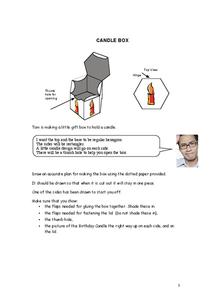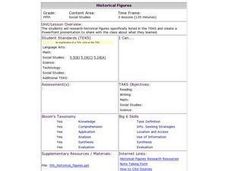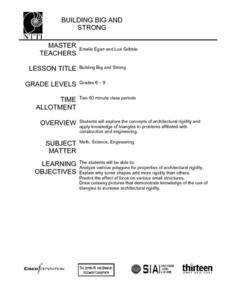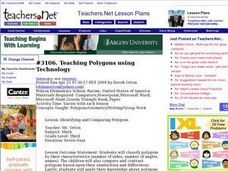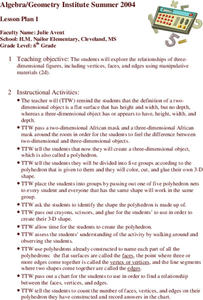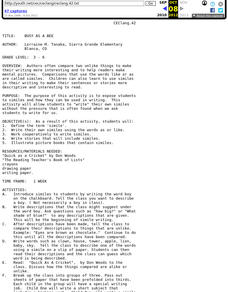Curated OER
Net "Working"
Upper elementary and middle schoolers explore the properties of various polygons. They use video, resource links, and engage in hands-on activities in order to construct geometric nets. This fine plan should lead to increased...
Mathematics Assessment Project
Candle Box
Individuals draw a net for a hexagonal pyramid — with some stipulations. The net must contain the printed images so they appear correctly on the box, along with tabs to glue the box together.
Curated OER
Edible Geometry
Students examine a chart that lists the main characteristics of polygons and 3 dimensional figures. They make examples of the polygons and figures using pretzels and gum drops showing how the gum drops are vertices and the pretzels are...
Curated OER
Pyramids and Prisms: Guler's Formula
Sixth graders detect and categorize the attributes of geometric shapes to solve problems. In this geometry lesson, 6th graders construct a variety of polyhedra. Students recognize the relationships between two dimensional and three...
Curated OER
Technology: Historic Figures
Fifth graders research historical figures and create Powerpoint presentations about them. They present their completed projects to the class. Students gfenerate one question about their figure which is included on a quiz.
Curated OER
Building Big and Strong
Middle and high schoolers explore the concepts of architectural rigidity. They analyze a variety of polygons, and explain why some shapes add more strength to structures than others. The PBS video, "Building Big," is utilized in this plan.
Curated OER
Toothpicks, Gumdrops, and Polyhedrons
Sixth graders use toothpicks and gumdrops to make prisms and pyramids. This helps them explore the relationship betweeen faces, vertices, and edges.
Curated OER
Ten Crucial Days- George Washington as a Hero Figure
Students identify the heroic qualities of George Washington. In this Revolutionary War activity, students recognize heroic qualities and construct a Hero Hall of Fame. Students construct posters that exemplify heroic traits.
Curated OER
Poetry Writing Unit: Writing a Film Poem
Film poems? To concluded a poetry unit, writers select one of their own poems and create a film that brings to life the sounds and images of their work. Included with the detailed unit plan are daily lessons, student examples, a list of...
Curated OER
Teaching Polygons using Technology
Third graders utilize different types of computer programs, such as Microsoft paint and Microsoft Word to study and create different types of polygons. They use PowerPoint to create a story about a shape and others that it meets during a...
Curated OER
Three-Dimensional Figures
Sixth graders explore three-dimensional objects. In groups, they create and decorate their own polyhedron design. After identifying the faces, vertices, and edges of the polyhedron, 6th graders determine a relationship between the...
Curated OER
Busy As a Bee
Students define the term 'simile,' write their own similes using the words as or like, and work cooperatively to write similes. In addition, students write stories that include similes and illustrate picture books that contain similes.
Curated OER
Build Your Dream Bedroom
Designers measure their own rooms and produce a scale drawing. They use the Internet to visit sites to find the costs of purchasing new carpet, paint, or anything else they would like to add to their room. Using a $1500 budget, they will...
Curated OER
Applying Proportionality in Scale Drawings
Sixth graders examine a blue print and discuss the reasoning behind using blue prints. In this proportionality lesson plan, students collaborate with their teammates to create a scale drawing. Once that is complete, 6th graders...
Curated OER
History: Declaration of Conscience Political Cartoons
Students examine political cartoons depicting opinions about Margaret Chase Smith's Declaration of conscience. After examining the cartoons, they create their own political cartoons about the speech. As an ongoing activity, students...
Curated OER
Shapes are Everywhere
Second graders gain an understanding of geometric shapes and spatial reasoning. They learn the attributes of solid shapes in everyday activities. Students compare geometric shapes to everday objects, finding things that serve a purpose...

